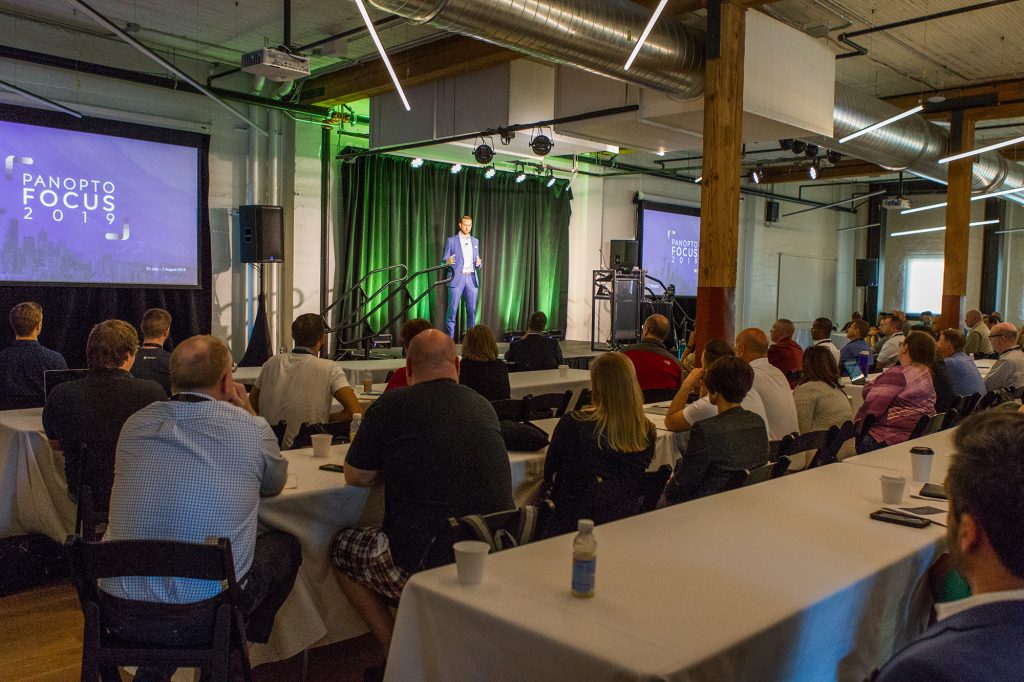2019 WAS A FIRST for Panopto, Duke’s lecture capture provider, in that they held their User Conference near company headquarters in downtown Seattle. As this was only their third North American user conference (the previous two were held in downtown Chicago), Panopto has been slow to venture into event hosting. We don’t think that’s necessarily a bad thing as it gave the impression Panopto had been focused more on evolving their product platform when that was most needed instead of on PR. However, now that they are one of the clear leaders in the lecture capture space, it makes sense for them to begin to invest in building community through events like these. (It should be mentioned that they’ve had 5 conferences in the EU, so are a bit farther ahead there.)
This year’s conference suggests they are clearly hitting their stride. The event was well organized and well-attended, and offered a chance to meet and talk with peers from institutions all over the world as well as many of the folks on their Dev, Support, and Product teams we’ve worked with remotely but hadn’t met in person yet. The conference was hosted in an inviting venue called Block 41 that functioned as an ice house in an earlier era. The food was great, and there were nice touches that made guests feel welcome. Panopto staff seemed to always be around and available to assist or just to chat. Hats off to Panopto for putting on a great show.
Duke spoke on our use of automated recording, something we’ve been focused on from our earliest days with Panopto. Other peer sessions focused on technical elements such as integrations with LMS’s and room control systems, and there were a number of informative sessions from Panopto’s Dev team and executive leadership on product direction. One significant change CEO Eric Burns announced was a new in-browser recording tool that looks like it may be powerful and simple enough to replace certain use cases for recording via the downloadable client software. VP of Engineering Tim Sullivan gave a helpful talk on the product roadmap. Neither of those talks are publicly available, but I’m guessing Panopto will be making more public announcements about what’s ahead for them soon. We have a link to the talks that were recorded and will share that with any interested peer institutions (email oit-mt-info@duke.edu).
The vendor selection was small but tightly focused group on core Panopto functions, such as appliances and captioning. Epiphan demoed it’s cool Pearl Mini, which offers webcasting to social media platforms in addition to simple lecture capture. It’s a higher end device with more manual controls than we need at Duke for automated recording, but impressive nonetheless. Shuttle was featuring its Panopto-certified device running Windows IoT (i.e., Windows 10 LTSB), and Matrox was showcasing its new Maevex 6020, the first true Linux appliance purpose-built for Panopto. We’ve been building and managing our own Windows appliances to work with Panopto at Duke since we started using Panopto in 2010. While we’ve worked out a lot of the kinks in the process over the years, the overhead in working with even the LTSB version of Windows is high, so the prospect of a Linux appliance is an interesting one to us.
Another nice part of the event for Duke was being able to participate on the new Internet2 NET+ Advisory Board for Panopto, which met the day before the conference in Panopto’s offices in historic Smith Tower. The Board consists of a number of schools who have been working with Panopto for some time, and is working now on developing some suggestions for Panopto as they consider their short and long-term product roadmap. Panopto’s investment in this group demonstrates their commitment to listening to customer feedback in an effort to make their product better. This type of responsiveness is something we’ve seen consistently from Panopto since we started using them in 2010, and is one of the reasons we remain satisfied with the product and services they offer.


